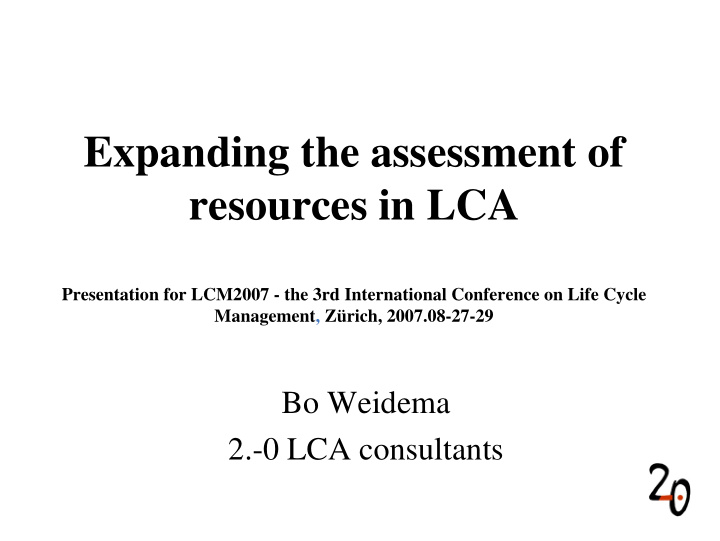



Expanding the assessment of resources in LCA Presentation for LCM2007 - the 3rd International Conference on Life Cycle Management, Zürich, 2007.08-27-29 Bo Weidema 2.-0 LCA consultants
Expanding the assessment of resources in LCA • Traditionally in LCA: Resources = Natural resources • thus ignoring human, social and manufactured resources • Hypothesis: The procedure currently used for impacts on natural resources in LCA (Müller-Wenk 1999, Stewart & Weidema 2005) can also be used for assessment of impacts on human, social and manufactured resources • Thereby, the impacts on human productivity (Weidema LCM2005: The integration of economic and social aspects in LCIA) can be integrated seamlessly in the LCIA of resources
Resources defined • Resource: an available means of production ( = Production factor) • human resources: the available labour force with its different productive abilities • biotic resources: the natural or manipulated biota with its inherent or artificially enhanced abilities to grow and propagate • abiotic resources: the natural or manufactured raw materials or catalysts for human or biotic production. • social resources: the social conditions, such as institutions, rule of law, trust, and human networks (prerequisites or catalysts for production, although not entering directly into production)
The value of resources • The value of a resource is defined in terms of the future production or consumption that it can sustain, i.e. its productivity • Damage to resources may thus be measured as the loss of potential output , typically measured in monetary value
Resources = Capital • Human capital World Bank (2002): 78% of all capital • Social capital • Natural capital - biotic 3%, abiotic 1% - 18% • Manufactured capital • and when monetised: Financial capital • The aggregate of all capital is also known as wealth Summarising: • A resource is an available means of production ( = Production factor = Capital), the value of which is its potential contribution to future output
Damage to resources External damage 1 Private costs (for manufacture and Resource type LCC LCIA maintenance) Human resources Costs of education and health care Health impacts, Missing education Social resources Costs of governance Corruption, […], Rent seeking Biotic resources - manufactured Costs of fertilisation, soil Pollution etc. management, rangeland management None (free good) 2 - natural Pollution etc. Abiotic resources - manufactured Manufacture and maintenance costs Pollution to compensate depreciation None (free good) 2 - natural Disintegration, dissipation 1) External damage may become a private damage (cost) if the damage is compensated by the responsible economic agent. 2) As a natural endowment, there are no manufacture costs of natural resources (but of course there are costs for their extraction). If there is private ownership of the resource, there will be a transfer of resource rents from the user to the owner, but this is not a net cost from a societal perspective.
LCC and LCIA People Planet Profit E.g. health and safety Costs of raw materials, Private costs E.g. costs of pollution expenditures, product wages, taxes, interest LCC prevention on capital liability expenses E.g. reduction in productivity due to E.g. reduction in human human health impacts, Externalities E.g. biodiversity well-being due to missing education due LCIA impacts from pollution pollution to child labour, or reduction in crop yields due to pollution
Rough assessment of the ”ressource productivity gap” • The accumulated loss of potential output resulting from current human activities: – Impacts on human ressources (health impacts, lost education, unemployment): 33000 USD/capita/year (Weidema LCM2005) – Impacts on social resources (market imperfections, corruption, rent seeking, lack of governance and social infrastructure): 33000 USD/capita/year (Weidema LCM2005) – Impacts on biotic resources (invasive species, ecotoxicity): 130 USD/capita/year – Impacts on manufactured abiotic resources: ~ 10 USD/capita/year (extrapolated from Rabl 1999) – Impacts on natural abiotic resources: ~ 1 USD/capita/year (based on data from Müller-Wenk 1999)
Conclusion • The procedure currently used for impacts on natural resources in LCA (future loss of output) can also be used for assessment of impacts on human, social and manufactured resources • Expressing all resource damage in the same (monetary) unit allows comparison of resource impacts, and reveals that damage to human and social resources is much more important than impacts from use of mineral resources
Thanks for your attention Questions?
Recommend
More recommend